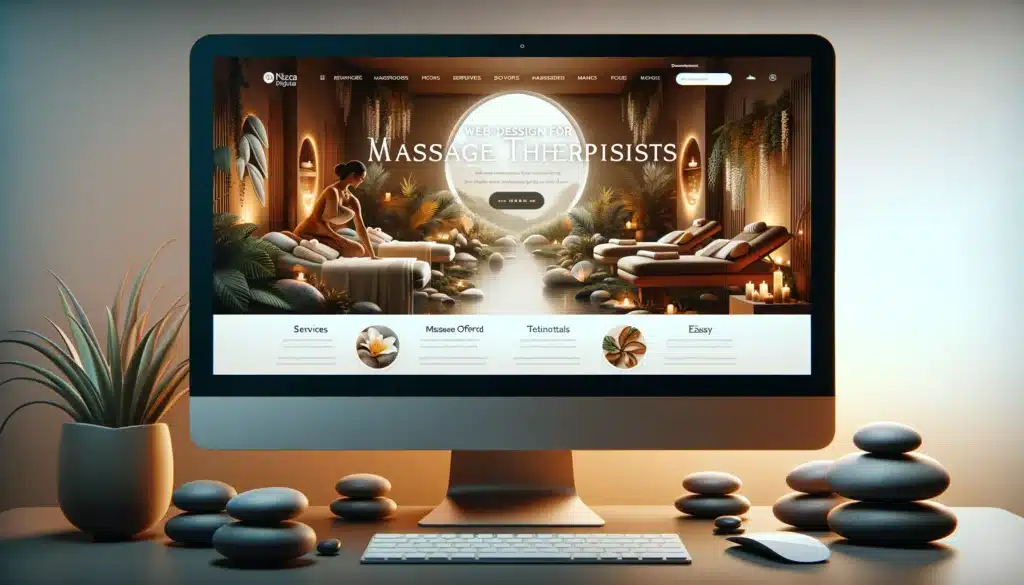
Are you a massage therapist looking to enhance your online presence and attract more clients?
We will explore the key elements of effective massage therapist websites, examples of successful sites, and best practices for designing a compelling online platform.
From user-friendly navigation to optimising SEO and showcasing social proof, we will cover everything you need to know to create a successful website.
Stay tuned for valuable tips and insights on web design for massage therapists.
Key Takeaways:
- Create a user-friendly website with high-quality imagery and compelling content to showcase your massage therapy services and attract potential clients.
- Utilise SEO strategies and local targeting to increase online visibility and reach a wider audience of potential clients.
- Incorporate social proof, such as client testimonials, to build credibility and enhance user experience on your website.
- Regularly update and maintain your website to improve brand consistency and attract more clients.
What’s included as standard?
Free SSL Certificate for website security (12 months).
Free domain registration (12 months).
Website created with user experience design (UX) in mind
Fast, free hosting (12 months).
Free website related business email (for example in**@yo********.com).
Mobile responsive design for all devices.
30 days support with ongoing monthly website maintenance option if required.
Enquire Today
Simply fill out the form or call us on
0161 486 6048

Introduction to Web Design for Massage Therapists
Creating a website is essential for massage therapists to showcase their services and reach a wider audience. At Nicada Digital, we specialise in providing top-notch web design services tailored to the unique needs of massage therapy professionals.
A well-crafted website not only serves as a digital shopfront but also acts as a virtual space where potential clients can learn about the therapist’s offerings, expertise, and approach to healing.
Having a visually appealing and user-friendly website can significantly enhance credibility and attract more clients, ultimately helping massage therapists grow their businesses.
Through strategic design elements, such as clear service descriptions, intuitive navigation, and engaging visuals, a website can effectively communicate the therapist’s brand and convert site visitors into loyal customers.
Key Elements of Effective Massage Therapist Websites
Effective massage therapist websites incorporate key elements that enhance the user experience and reflect the brand’s identity. These elements encompass the design, layout, and overall aesthetic appeal of the site.
One crucial component for ensuring a successful massage therapist website is user-friendly navigation. This means that visitors can easily find information about services, pricing, and booking appointments. Engaging content, such as blog posts about wellness tips, self-care techniques, or client testimonials, is another vital aspect to create a connection with potential clients and establish expertise. A cohesive branding strategy that reflects the values and mission of the practice helps build trust and credibility. To stand out in a highly competitive market, a visually appealing website with high-quality images and easy-to-read text can attract and retain visitors.
User-Friendly Navigation and Mobile Responsiveness
User-friendly navigation and mobile responsiveness are crucial aspects of a well-designed massage therapist website. Ensuring easy access to information and a seamless browsing experience on various devices is key to engaging clients.
When potential clients visit a massage therapy website, they expect a smooth and intuitive navigation system that guides them effortlessly through services, pricing, and scheduling options. A responsive design that adapts to different screen sizes and resolutions ensures that your website looks great and functions perfectly on smartphones, tablets, and desktop computers alike.
By incorporating clear menus, concise headings, and strategically placed call-to-action buttons, you can improve user experience and encourage visitors to explore your site further. Whether they are searching for relaxation massage, deep tissue therapy, or gift certificates, they should find what they need with ease.
High-Quality Imagery, Compelling Content, and Contact Information
High-quality imagery, compelling content, and accessible contact information are essential components of a successful massage therapist website. Engaging visuals and informative content can captivate visitors and encourage them to take action.
When a potential client lands on a massage therapist’s website, they seek not only relaxation but also professionalism and expertise. Hence, using high-quality images that showcase the ambience of the spa or the therapist in action can create an immediate positive impression. Well-crafted content that explains services, benefits, and techniques in a clear and engaging manner can build trust and intrigue. Providing clear contact information, such as phone numbers, email addresses, and appointment booking options, ensures that interested individuals can easily reach out for more information or schedule a session.

Examples of Successful Massage Therapist Websites
Examining successful massage therapist websites can provide valuable insights into effective design strategies and content presentation. These examples showcase best practices in web design that resonate with clients and drive business growth.
For instance, MassageEnvy.com exemplifies a well-rounded website that balances informative content with an easy-to-navigate layout. Their use of soothing colours and high-quality images creates a visually appealing experience for visitors.
Similarly, ElementsMassage.com focuses on clear calls-to-action and user-friendly booking systems, streamlining the client journey and enhancing user engagement. This seamless integration of online scheduling tools simplifies the process for clients, resulting in increased conversion rates.
Best Practices for Designing a Massage Therapist Website
Implementing best practices in web design for massage therapists is essential for creating a compelling online presence that attracts clients. From showcasing services to integrating online booking systems, each aspect plays a crucial role in enhancing user experience.
One of the key elements in website design for massage therapists is highlighting the range of services offered. Utilise engaging visuals and clear descriptions to showcase various massage techniques, special packages, and pricing information. This helps potential clients understand the offerings at a glance and encourages them to explore further. Integrating an online booking system directly on the website simplifies the appointment process, making it convenient for clients to schedule sessions. Streamlined navigation and responsive design are also vital features that contribute to a user-friendly website experience for visitors.
Understanding Target Audience and Design Elements
Understanding the target audience and aligning design elements with their preferences are fundamental steps in creating a successful massage therapist website. Tailoring the design to resonate with the intended clients can significantly impact user engagement and conversion rates.
By identifying the specific demographics, interests, and needs of the target audience, massage therapists can develop a website that speaks directly to their potential clients. Utilising branded colour schemes, typography, and imagery that evoke a sense of relaxation and wellness can enhance the overall user experience. Incorporating visually appealing elements such as high-quality photos of spa facilities, testimonials, and treatment options can build credibility and trust among visitors.
Highlighting Services and Online Booking Integration
Highlighting services and integrating online booking capabilities streamline the client experience and facilitate appointment scheduling on massage therapist websites. Clear service descriptions and easy booking options can enhance user convenience and drive conversions.
By clearly outlining the range of services offered, clients can readily identify the treatments that best suit their needs. Incorporating online booking features not only saves time for both the therapist and the client but also ensures a seamless process from browsing services to securing an appointment. User-friendly interfaces play a crucial role in providing a smooth experience, allowing clients to effortlessly navigate through available time slots and book their preferred sessions. With the convenience of online booking systems, individuals can easily schedule their massages at their own convenience, leading to improved customer satisfaction and loyalty.
Optimising SEO for Massage Therapist Websites
Optimising SEO for massage therapist websites is crucial for enhancing online visibility and attracting potential clients.
Regarding online marketing, using the right keywords is essential for driving traffic to your website. Conducting thorough keyword research to understand what your target audience is searching for can significantly impact your site’s rankings. By strategically placing these keywords in the website’s content, meta tags, and headers, therapists can cater to both search engine algorithms and user intent. Incorporating local SEO techniques such as including location-specific keywords and creating Google My Business listings can help therapists target their services to specific areas. This not only improves search engine rankings but also increases the chances of reaching potential clients in their vicinity.
Keyword Research and On-Page SEO Strategies
Conducting thorough keyword research and implementing on-page SEO strategies are essential for improving the search engine performance of massage therapist websites. By targeting relevant keywords and optimising on-page elements, therapists can boost their online presence and attract more clients.
Regarding keyword research, understanding the intent behind potential search queries is crucial. This involves identifying the specific terms and phrases that potential clients are likely to use when searching for massage services online. By incorporating these keywords strategically throughout the website content, meta tags, and headings, therapists can increase their chances of ranking higher in search engine results.
Effective on-page optimisation involves more than just adding keywords. Creating high-quality, engaging content that resonates with the target audience is also essential. This could include informative blog posts, visually appealing images, client testimonials, and service descriptions that are both informative and persuasive. By delivering valuable content that addresses the needs and interests of potential clients, therapists can not only improve their SEO rankings but also establish credibility and trust with visitors.
Local SEO for Targeting Specific Areas
Implementing local SEO strategies enables massage therapists to target specific geographical areas and connect with local clients seeking therapy services. By optimising location-based keywords and business information, therapists can improve their visibility in local searches.
This approach is especially crucial for small businesses like massage therapy practices, as it helps them stand out in competitive markets and reach potential clients in their vicinity. Creating a Google My Business listing with accurate business details, such as business name, address, phone number (NAP), and hours of operation, is essential for local SEO success. Including these details consistently across all online platforms and directories can boost credibility and trust among local customers.
Importance of Social Proof and Testimonials
Social proof and client testimonials play a vital role in establishing credibility and building trust on massage therapist websites. Showcasing positive feedback and testimonials from satisfied clients can significantly influence potential customers.
When visitors come across authentic testimonials highlighting the positive experiences of others, it reassures them of the quality of service they can expect. This transparency creates a sense of reliability and authenticity, which are crucial elements for converting website visitors into actual clients. Incorporating social proof can also help highlight the expertise and professionalism of the therapist, further solidifying the decision-making process for potential clients.
Showcasing Client Testimonials and Building Credibility
Showcasing client testimonials and building credibility through social proof are essential strategies for enhancing the reputation of massage therapist websites. Positive feedback and testimonials can instil trust in potential clients and encourage them to book services.
By prominently displaying client testimonials on a website, potential customers can gain insight into the experiences of others and feel assured in the quality of service. Including a diverse range of feedback, such as positive comments on technique, ambience, and customer service, helps create a comprehensive picture of the therapist’s skill and professionalism.
Integrating a dedicated section for testimonials, complete with star ratings or customer ratings, can offer a quick visual summary of the overall satisfaction level. This not only adds credibility but also serves as a quick reference point for visitors browsing through the site.
Enhancing User Experience on Massage Therapist Websites
Delivering a seamless user experience on massage therapist websites involves optimising loading speed, incorporating clear call-to-actions, and engaging users with multimedia content. Enhancing usability and accessibility can significantly impact client engagement and retention.
One crucial aspect to consider is the loading speed of the website. A slow-loading site can deter potential clients and lead to high bounce rates. Implementing strategies to improve loading times, such as optimising images and minimising unnecessary scripts, can make a notable difference in user experience.
- Clear call-to-actions play a vital role in guiding visitors through the website and encouraging them to take desired actions, such as booking an appointment or exploring services further.
- Integrating multimedia content like high-quality images, videos, or virtual tours can provide a more immersive experience for users, helping them better understand the services offered and creating a lasting impression.
Fast Loading Speed, Clear Call-to-Actions, and Multimedia Content
Fast loading speed, clear calls-to-action, and engaging multimedia content are key components of enhancing user experience on massage therapist websites. Ensuring swift navigation, intuitive actions, and interactive elements can create a positive impression on visitors.
Optimising loading speed is crucial as it directly impacts the time visitors spend on the site. Implementing clear calls-to-action guides users on their journey, prompting them to take desired actions effortlessly. Including intriguing multimedia content such as videos showcasing massage techniques or soothing background music elevates user engagement levels, making the website more interactive and visually appealing.
Conclusion and Final Tips for Web Design Success
Maintaining brand consistency, updating content regularly, and monitoring website analytics are essential practices for ensuring web design success for massage therapists. These strategies contribute to sustained growth and improved online visibility.
Consistency in branding helps in establishing a recognisable identity that resonates with visitors, engendering trust and loyalty. Through regular content updates, massage therapists can showcase their expertise, engage with clients, and stay relevant in a competitive market.
By monitoring website analytics, therapists can gather valuable insights into visitor behaviour, popular pages, and conversion rates. This data-driven approach allows for knowledge-based decision making and targeted optimisations to enhance the overall user experience.
For enhanced performance and long-term success, focus on optimising site speed, mobile responsiveness, and clear call-to-action buttons. Embracing search engine optimisation (SEO) techniques and leveraging social media integration can further boost online reach and engagement.
Maintaining Brand Consistency and Updating Content Regularly
Maintaining brand consistency and regularly updating content are pivotal strategies for ensuring the success of massage therapist websites. Consistent branding and fresh content contribute to improved user engagement and retention.
Brand consistency is crucial as it helps establish a recognisable identity for your massage therapy practice. When users visit a website that reflects consistent branding, they are more likely to perceive the business as professional and trustworthy. Regularly updating content ensures that visitors have access to relevant and valuable information, keeping them engaged and coming back for more. It also signals to search engines that the website is active and up-to-date, improving its visibility and search ranking.
Monitoring Website Analytics for Improvement
Monitoring website analytics is essential for identifying areas of improvement and optimising the performance of massage therapist websites. By analyzing user behaviour and engagement metrics, therapists can make informed decisions to enhance the overall user experience.
By utilising tools like Google Analytics, therapists can gain valuable insights into their website traffic, such as the number of visitors, popular pages, bounce rates, and referral sources.
This data allows them to adapt their content and services to meet the specific needs and interests of their audience, ultimately leading to increased conversion rates and customer satisfaction.
Tracking analytics helps in evaluating the effectiveness of marketing campaigns and SEO strategies, enabling therapists to allocate resources wisely based on data-driven decisions.
Frequently Asked Questions
What is web design for massage therapists?
Web design for massage therapists is the process of creating a website specifically tailored to the needs of massage therapists. It involves creating a visually appealing and user-friendly website that effectively communicates the services and benefits of massage therapy.
Why do massage therapists need their own website?
Having a website is crucial for massage therapists as it acts as a digital storefront for their services. It allows potential clients to easily find and learn about their services and can serve as a booking platform to increase business and attract new clients.
How can Nicada Digital help with web design for massage therapists?
At Nicada Digital, we have a team of experienced web designers who specialise in creating websites for massage therapists. We understand the unique needs of this profession and can tailor a website that effectively showcases your services and attracts clients.
What makes Nicada Digital the best choice for web design for massage therapists?
As a digital agency that specialises in web design for massage therapists, we have a deep understanding of the industry and what clients are looking for. We also have a track record of successful websites for massage therapists, and our team is dedicated to providing top-notch customer service.
What are the key elements of a successful website for massage therapists?
A successful website for massage therapists should have a clean and visually appealing design, easy navigation, clear information about services and pricing, and a way to book appointments online. It should also be optimised for search engines to ensure it can be found by potential clients.
How long does it take to create a website for a massage therapist?
The timeline for creating a website for a massage therapist can vary depending on the specific needs and requirements. However, at Nicada Digital, we work efficiently to deliver a high-quality website in a timely manner, typically within 4-6 weeks.

Please Get In Touch …
Please get in touch and we’ll be very happy to discuss your project requirements and will offer expert, friendly advice.
Phone:
Email:
Website Form:
Times:
Mon – Fri 9am – 5pm
